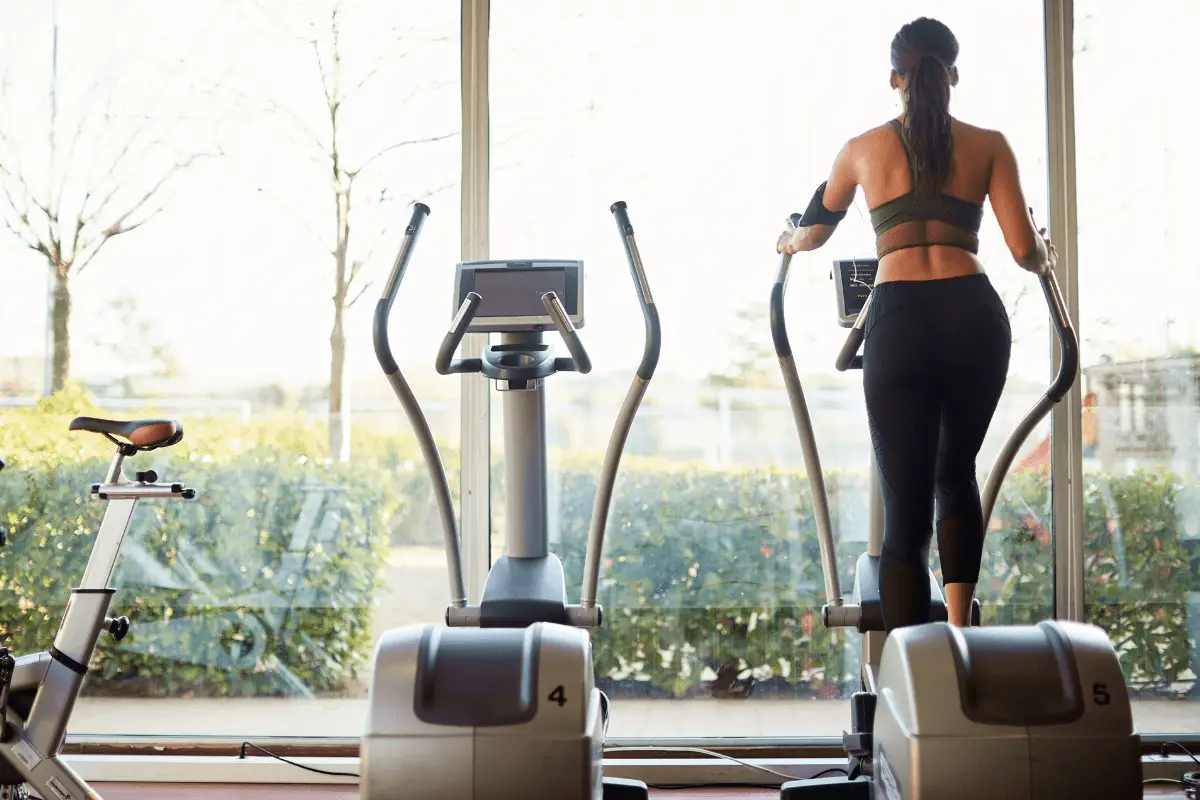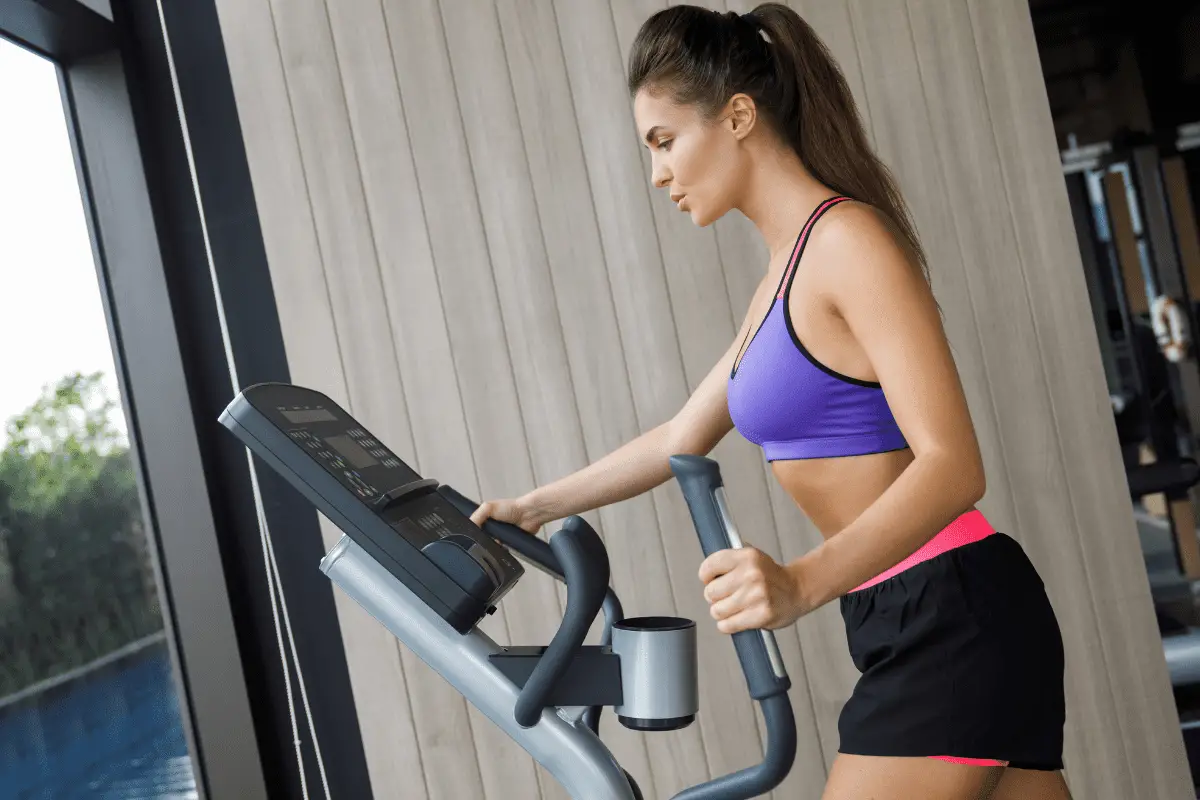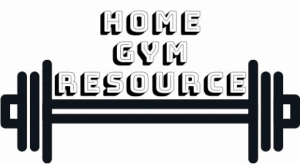You’ve seen elliptical trainers in the gym or in pictures but it can be difficult to gauge how big they actually are. What are the dimensions of common and popular home gym elliptical trainers and how much space do you need in your home gym to actually use one? Let’s find out.
In general, elliptical trainers are between 55” and 80” long and between 25” and 32” wide. To be able to use an average elliptical trainer properly, a free space of 8’ by 4’ is big enough for comfortable use. More space on one side will improve airflow.
Below you can find a list of popular models of elliptical trainers for a home gym and their exact dimensions. You’ll also find how much space you need around the machine to be able to use it properly.
Contents
Elliptical trainer dimensions
Here is a list of elliptical trainers with many popular models from different brands. These are the dimensions listed by the manufacturer.
| Brand | Model | Length | Width | Height | Stride length | Step up height |
|---|---|---|---|---|---|---|
| Lifefitness | E1 | 82 | 30 | 59 | 20 | 6.5 |
| E3 | 82 | 34 | 61 | 20 | 6 | |
| E5 | 84 | 34 | 66 | 18-24 | 10 | |
| Body Solid | BFCT1 | 45 | 26 | 66 | ? | ? |
| BFE2 | 48 | 30 | 66 | |||
| E300 | 50 | 31 | 66 | 21 | 8 | |
| E400 | 50 | 31 | 66 | 17-21 | 8 | |
| E5000 | 68 | 31 | 69 | 21 | ||
| BodyCraft | ECT400G | 71 | 28.5 | 66 | 23 | 12 |
| ECT500G | 71 | 28.5 | 68 | 23 | 12 | |
| ECT800G | 68 | 26 | 63.5 | 20.5 | 7.5 | |
| Bowflex | Max Total | 49.2 | 30.5 | 65.1 | ||
| Max M8 | 47.9 | 30.8 | 65.2 | |||
| Max M6 | 46 | 26 | 64.2 | |||
| Horizon Fitness | EX-59 | 68 | 25 | 64 | 18 | 10 |
| 7.0 AE | 76 | 24 | 65.5 | 20 | 10 | |
| Peak Trainer | 47 | 28 | 66 | 12 vertical | 10 | |
| Sole | E25 | 70 | 24 | 71 | 20 | 14 |
| E35 | 82 | 31 | 71 | 20 | 14 | |
| E95 | 82 | 31 | 71 | 20 | 14 | |
| E55 | 71 | 27 | 71 | 20 | 14 | |
| E95S | 84 | 32 | 71 | 20 | 14 | |
| E98 | 82 | 31 | 71 | 20 | 14 | |
| Nautilus | E616 | 71.5 | 26.7 | 63.2 | 20 | |
| E618 | 73 | 26.97 | 66.97 | 22 | ||
| Octane Fitness | Q35 | 76 | 26 | 61.75 | 20.5 | 4 |
| Q37 | 76.5 | 34 | 61.75 | 20.5 | 4 | |
| Q47 | 84.5 | 37.5 | 63 | 18-26 | 5 | |
| XT-ONE | 92 | 33 | 64.75 | 20-28 | 5 | |
| Sunny Health | SF-E3957 | 65 | 26 | 68 | 16 | |
| SF-E3981 | 69.3 | 28.7 | 64.8 | 16 | ||
| SF-E1405 | 33 | 25.6 | 60.3 | 12 | ||
| SF-E3803 | 46 | 25 | 61 | 11 | ||
| SF-E3804 | 43 | 24 | 62.5 | |||
| SF-E3875 | 62 | 26 | 70 | 19.5 | ||
| SF-E3912 | 55 | 23 | 64.5 | 15.5 | ||
| Precor | EFX200 | 75 | 29 | 65 | 18-21 | |
| EFX400 | 84 | 31 | 67 | 21-24 | ||
| EFX600 | 80 | 30 | 67 | 21-24 | ||
| EFX700 | 80 | 28 | 67 | 22.5 | ||
| EFX800 | 80 | 28 | 67 | 21-25 | ||
| Freemotion | e10.9b | 85 | 27 | 63 | 20 | 9.5 |
| e9.8b | 83.5 | 24.6 | 62.7 | 20 | 9.5 | |
| Schwinn | 470 Elliptical | 70.1 | 28.2 | 63.2 | 20 | |
| 430 Elliptical | 70.1 | 28.2 | 63.2 | 20 | ||
| 411 Elliptical | 53.8 | 24 | 62.5 | 18 | ||
| 68.1 | 28.5 | 65.5 |
There are pretty big differences between the sizes of the different models but here is the average;
The average size of an elliptical trainer is 68.1” long x 28.5” wide x 65.5” high.
The length is the dimension that differ the most between the different models. This is because where design and architecture decisions have the biggest impact. The position of the flywheel plays a big part here.
Elliptical trainers have their flywheel either in the front or in the rear. In general, front wheel drive elliptical trainers are shorter while rear drive cross trainers are longer.
There are some other differences in front and rear flywheel ellipticals besides the size. Click here to find more about that.
Let’s take a look at the length, width and height separately.
Click here to find a recommend home gym elliptical trainer
How long is an elliptical trainer?
The average length of elliptical trainers is 68.1” or 173 cm.
Lengths range from 33” to 92”. The majority of models is between 55″ and 80″ long although there are plenty of exceptions to this.
Suggested post: Is 30 minutes on an elliptical trainer enough?
The shorter models tend to be set up a bit differently than the longer ones. The shorter models usually have more vertical movement than forwards and backwards. This makes the machine more compact but also changes the movement. The movement is more like climbing stairs than running. That’s not necessarily a bad thing, just be aware of the difference.
Another way manufacturers make the machines shorter is by using a small flywheel and short stride length. That’s especially the case on entry level trainers. These things aren’t really personal preference a small flywheel makes the ride less smooth and a short stride length makes the movement feel unnatural.
Suggested post: How long should elliptical stride length be for you?
Also, just looking at the length of a cross trainer is a bit misleading. That’s because the footprint doesn’t take into account the movement of the pedals.
The pedals move back and forth. On some machines they can actually move outside the stated dimensions of the machine. Not all machines actually do this and on which side they poke out depends on the location of the flywheel. If the flywheel is in the rear, the pedals can stick out on the front and vice versa.
In machines where this happens, it’s usually not very far but it’s something to keep in mind.
How wide is an elliptical trainer?
The average width of an elliptical trainer is 28.5”/72.4 cm.
Widths range from 24” to 37.5”. The range isn’t nearly as big as with the length but there are still pretty big differences. Most machines are between 25″ and 32″. That means that the total footprint of an elliptical trainer is generally quite a bit smaller than that of a treadmill.

How tall is an elliptical trainer?
The average height of an elliptical trainer is 65.5” with heights ranging from 59” to 71”.
The total height of an elliptical trainer isn’t the most important dimension. 99% of people will be taller than the total height of the machine anyways.
The ceiling height you put the trainer under is very important. However, that’s related to the step up height and your personal height and not so much the total height of the trainer.
You can read more about the necessary ceiling height to use an elliptical trainer below.
How much space do you need for an elliptical trainer?
Above you can see how big the typical elliptical trainer is. That doesn’t exactly tell you how much space you need to actually use one. Of course the size and how much space you need are related. However, since elliptical trainers have different sizes, they do need different amounts of space.
You’ll need some space around the trainer to be able to use it. Let’s look at the different dimension and what you have to think about when choosing your elliptical and where to place it.
An average elliptical trainer needs 7’ by 3.5’ of free floor space to be used comfortably. This leaves enough free space on every side so your body or the machine won’t interfere with the wall. More space on at least one side will be much more comfortable because of airflow.
Adding a foot to the length and width of your specific machine will work to get you to the amount of free space you need for your home elliptical trainer.
How much length does an elliptical trainer need?
How much length do you need for an elliptical trainer?
Different machines work in different ways. How it works does make a difference in how much space you still need in front or behind the trainer.
Sometimes the levers and other parts of the elliptical swing outside of the quoted length of the machine. This doesn’t happen on all models but it does on some. On the machines where this happens, it’s usually 3 inches at most. That means you’ll need about 4 inches more length to make sure you don’t hit the wall.

Another thing to keep in mind is that you have to get onto the elliptical somehow. Most front drive elliptical trainers are designed to be mounted from the rear. If there is a wall exactly where the machine ends, it’ll be quite difficult to step onto the machine. For that reason it’s good to keep at least a foot of free space behind the elliptical if you’re able bodied. If you’re not as mobile as a human could be, having a bit more than one foot is a good idea.
Rear drive cross trainers are usually mounted from the side. That means you’ll need at least one foot of free space next to it.
How wide a space does an elliptical trainer need?
With the width, it’s a bit easier. 99% of the elliptical trainers only more forwards and backwards and don’t have lateral motion. Octane fitness is an exception, check them out if you’re interested.
That means you don’t need a whole lot of extra space next to your elliptical. What you need is;
- Enough space to get on the machine if you want to step on from the side.
- Enough width to comfortably stand on the machine without rubbing your shoulders or other body parts on the wall.
This means that in most cases you just need a few inches on both sides to comfortably use your trainer. Add a foot to the width of the width of your specific model and that’s the width you need to properly use your elliptical trainer without bumping in to anyone.
Most home elliptical trainers are designed to be stepped on from the rear but if you want to get on from the side you need a bit more space on one side. About a foot of width on one side of the machine is the minimum to have enough room to step on in that case.

How tall does your ceiling have to be for an elliptical trainer?
Height is an important dimension many people tend to forget when buying any gym equipment for their home gym.
As with all dimensions, if your gym is big enough, you might never think about it. But if it isn’t big enough you might not be able to actually use the machine. So that’s why it’s pretty important to think about.
A safe estimation is to have 2 feet of headroom on top of your personal height. So if you’re 6’ tall, your ceiling should be 8’ tall to safely use any elliptical trainer. That 8’ should be from the floor, so if you’re using thick gym flooring, take that into consideration.
However, that two feet is a safe general estimation. That will allow you to use the tallest machines. There are quite a few elliptical trainers which have an easy to use, low step up height. The lower the step up height the lower your ceiling has to be to be able to stand under it on the trainer.
Suggested post: How much weight can an elliptical machine handle?
If you want to know how much headroom you need exactly, do the following;
- Find out the step up height of your trainer.
- Add your height to the step up height.
- Add another 5” to 10” to that.
So if you have a machine with a step up height of 8” and you’re 6’ tall that looks like this;
8” + 72” + 10”= 90” or 7.5’
That means that a 6’ tall person combined with an elliptical machine that has a step up height of 8” can safely use this under a ceiling that’s 7.5’ high.
Make sure there is nothing mounted on the ceiling above your trainer that actually lowers that height like a lamp.
Related questions
Is a large elliptical trainer better? Elliptical trainers that are bigger in size usually have stronger frames, bigger flywheels and longer stride lengths. That means a smoother and more natural feeling trainer that won’t limit you in any way.
Does elliptical flywheel size matter? A bigger flywheel in an elliptical trainer will do two things; Have more weight and allow for a longer stride length. Both of those are important for a smooth ride and natural feeling stride. A heavier flywheel will want to keep moving for longer which smooths out the movement. If you’re taller, you need a longer stride length to not feel cut short.
Favorite Cardio Accessories
Check out these accessories that improve a home cardio workout:
- Equipment mat: All cardio equipment should be put on an equipment mat. The Rubber-Cal mat (Amazon) is an affordable yet very high-quality choice.
- Interval timer: To time your intervals and workouts, there is no better choice than the GymNext Flex. It’s super easy to use and set up with a phone app.
- Tablet holder: Cardio can be boring. With this tablet holder (Amazon) you can follow along with on-demand workouts or just watch a movie on any cardio machine.
- Heart rate monitor: Monitoring your heart rate is very important while doing cardio. The Polar H10 (Amazon) connects to almost anything you can imagine and is very accurate.
To find which cardio machines I recommend for home gyms, click here.

